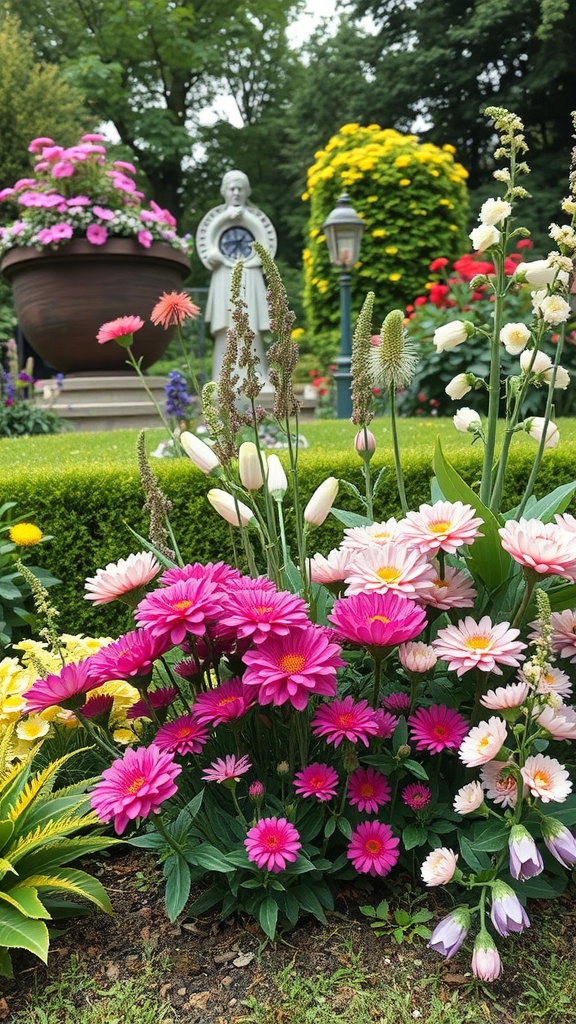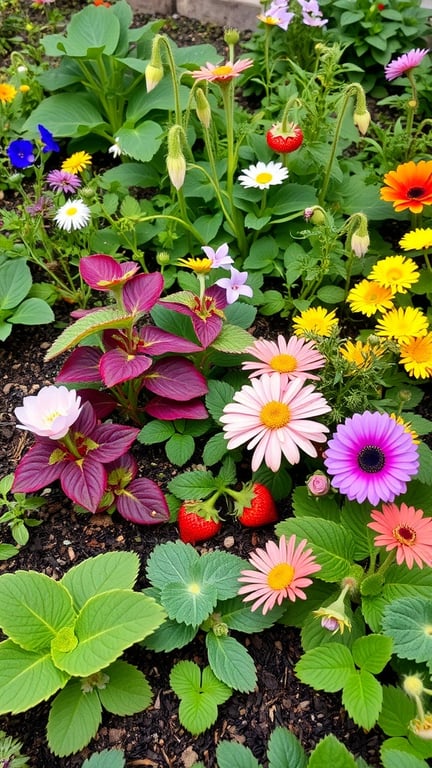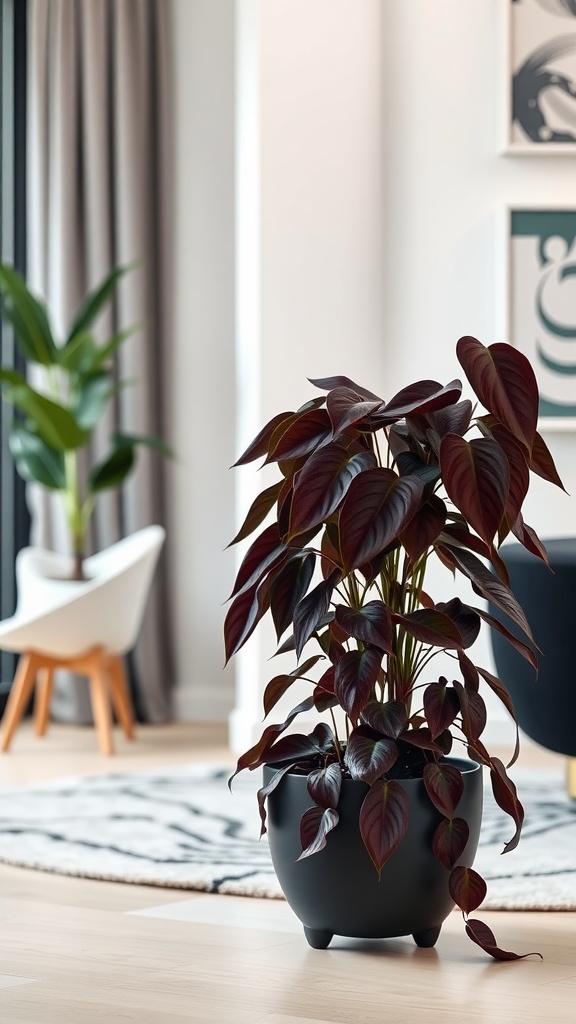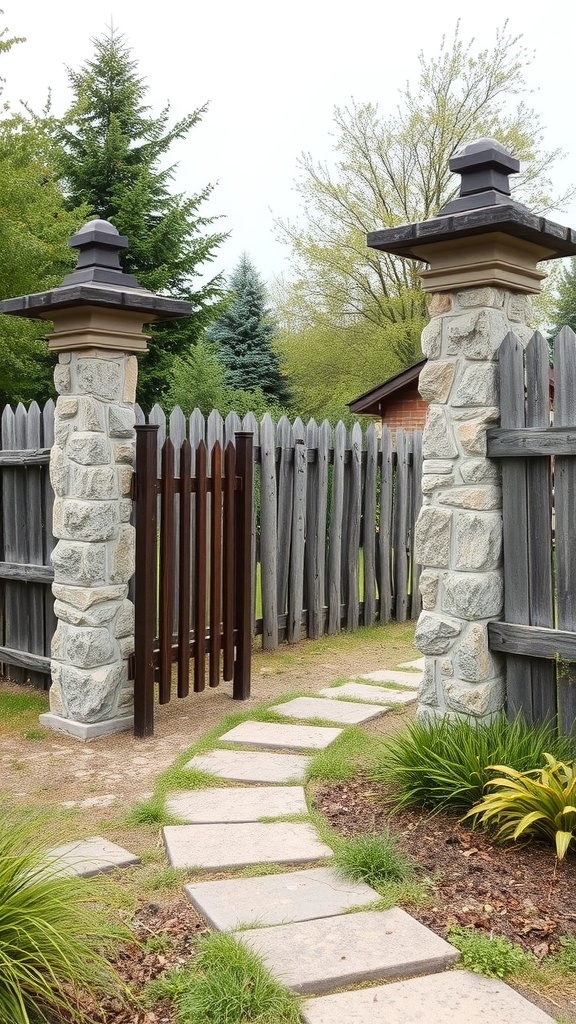25+ Inspiring Small Balcony Garden Ideas for Your Outdoor Space
Creating a small balcony garden can be a fun and rewarding way to bring a touch of nature to your living space. With a little creativity and the right plant choices, you can transform even the tiniest balcony into a blooming retreat. Here are 25+ ideas to help you get started on your green thumb journey!
Maximizing Sunlight Exposure
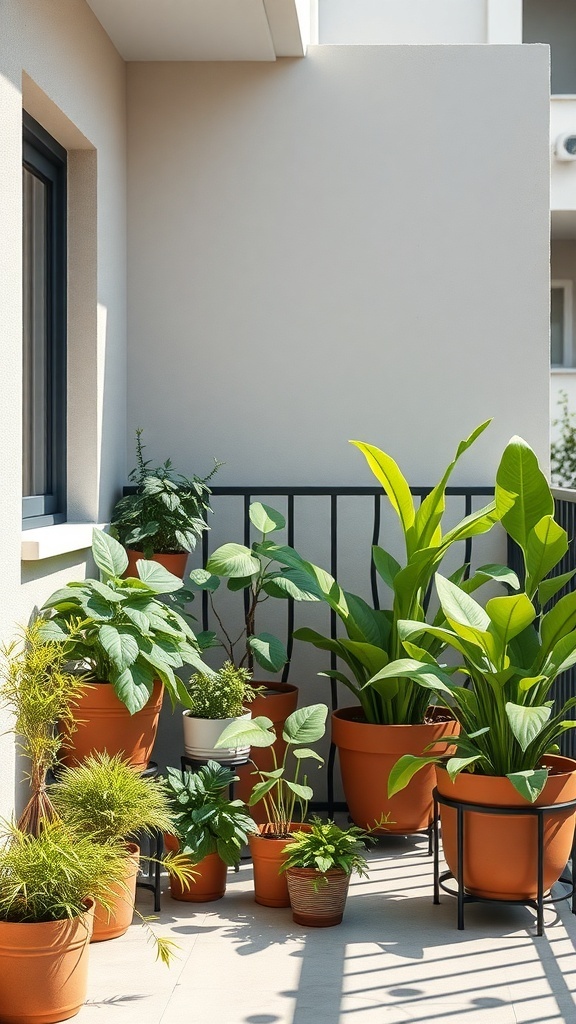
In a small balcony garden, sunlight is your best friend. The image shows a vibrant collection of plants in various pots, all soaking up the sun. Each plant has its own unique shape and size, creating a lively atmosphere.
To make the most of your space, position taller plants where they can catch the most light. This way, shorter plants won’t be overshadowed. Consider using plant stands to elevate some pots. This adds dimension and helps ensure every plant gets its fair share of sunlight.
Another tip is to rotate your plants regularly. This simple action can help them grow evenly and prevent any one side from becoming leggy. Also, pay attention to the time of day when the sun hits your balcony. Adjust your plant placement accordingly to maximize exposure.
Finally, don’t forget about the type of plants you choose. Some thrive in full sun, while others prefer partial shade. Mixing these can create a balanced look while ensuring all your plants are happy.
Seasonal Planting Calendar

Creating a small balcony garden can be a fun and rewarding experience. The image showcases a vibrant balcony filled with various plants in pots, making the most of limited space. This setup is perfect for anyone looking to add some greenery to their home.
When planning your seasonal planting calendar, think about the types of plants that thrive in each season. In spring, you might want to start with colorful flowers like petunias or geraniums. These can add a cheerful touch to your balcony.
As summer rolls in, consider adding herbs like basil or mint. They not only look great but can also be used in your cooking. In the fall, you can switch to hardier plants that can withstand cooler temperatures, such as pansies or ornamental kale.
Winter might seem challenging, but you can still keep your balcony lively with evergreen plants or even some indoor-friendly varieties. Keeping a seasonal calendar helps you rotate plants and keep your balcony looking fresh year-round.
Herb Garden Essentials

Creating a small balcony herb garden can be a delightful experience. The image shows a row of potted herbs, each thriving in its own terracotta pot. These pots are lined up neatly, showcasing a variety of herbs that can bring flavor to your meals.
When starting your herb garden, think about the herbs you use most often. Basil, mint, and rosemary are popular choices. They not only add taste but also fill your space with wonderful scents. Make sure to choose pots that have good drainage to keep your herbs healthy.
Another tip is to place your pots where they can get plenty of sunlight. Most herbs love the sun, so a sunny balcony is perfect. Water them regularly, but be careful not to overdo it. Herbs prefer slightly dry soil between waterings.
Consider adding a few decorative elements to your balcony garden. Small garden tools or colorful labels can add a personal touch. Enjoy the process of watching your herbs grow and don’t hesitate to snip a few leaves for your cooking!
Creating a Cozy Seating Area

Imagine stepping out onto your small balcony and feeling instantly relaxed. This cozy seating area is perfect for unwinding after a long day. The two wicker chairs invite you to sit back and enjoy a good book or a cup of coffee.
Bright pillows add a splash of color, making the space feel warm and welcoming. The round rug underfoot creates a defined area, giving it a homey touch. Surrounding plants bring life and freshness, making it a little green retreat.
The natural light streaming in enhances the overall vibe. A few hanging plants add height and interest, drawing the eye upward. This little corner can easily become your favorite spot to relax and recharge.
Container Planting Ideas
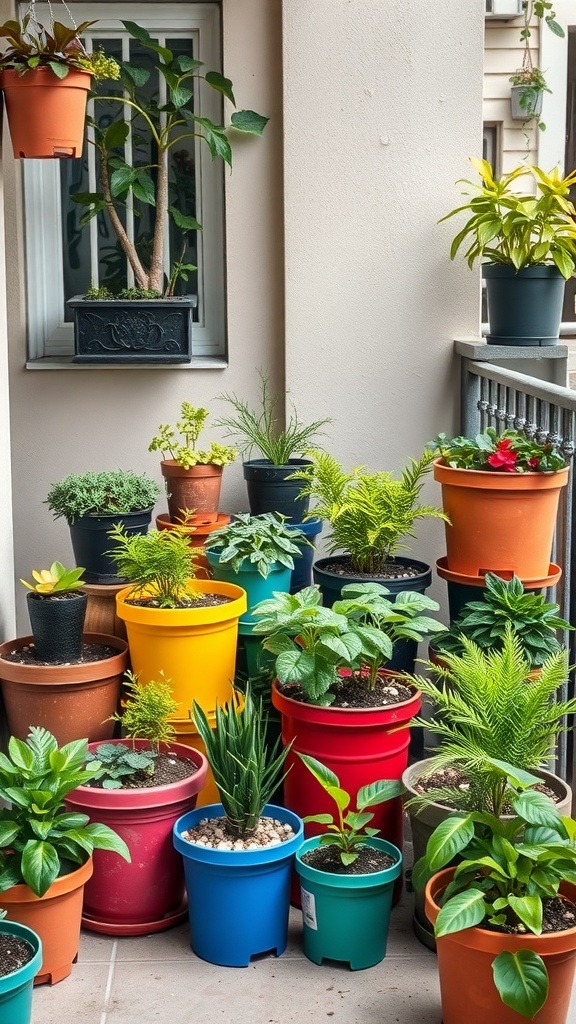
Creating a small balcony garden can be a fun and rewarding experience. Container planting is a great way to maximize your space while adding greenery to your outdoor area. The image shows a vibrant collection of potted plants in various colors and sizes, showcasing how you can mix and match to create an eye-catching display.
Start with a variety of pots. You can use terracotta, ceramic, or even recycled containers. The different colors and textures add visual interest. Grouping pots of different heights can create depth and make your balcony feel more dynamic.
Consider the types of plants you want. Herbs like basil and mint are perfect for small spaces and can be used in your cooking. Flowering plants such as petunias or geraniums can bring bursts of color. Don’t forget about leafy greens like lettuce or spinach, which can thrive in containers.
Using vertical space is key. Hanging planters or wall-mounted pots can help you utilize every inch of your balcony. This not only saves space but also adds layers to your garden.
Lastly, think about the arrangement. Place taller plants at the back or center and shorter ones in front. This way, every plant gets the sunlight it needs while creating a lush, full look.
DIY Rail Planters
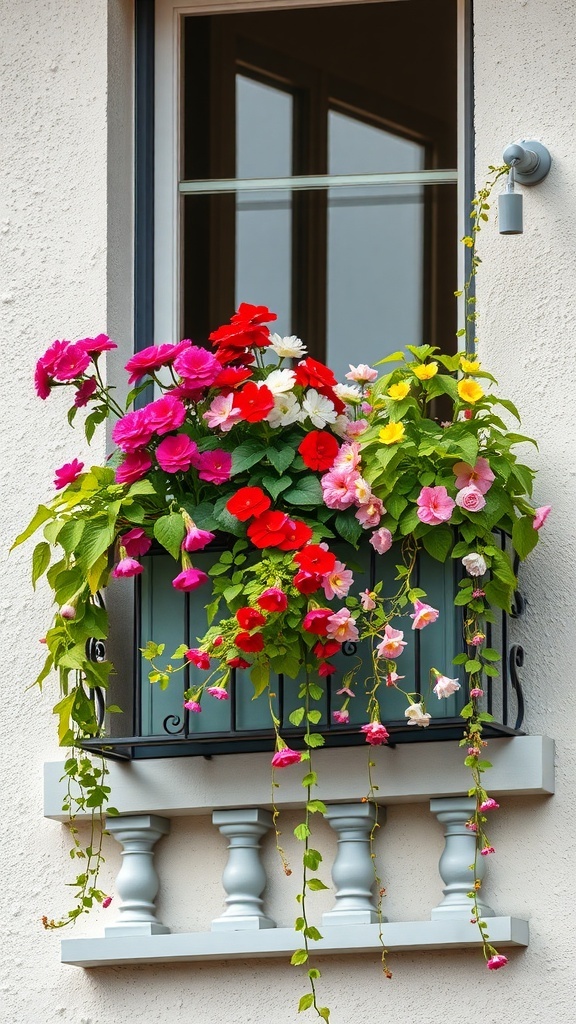
Rail planters are a fantastic way to make the most of small balcony spaces. They add color and life without taking up too much room. Imagine vibrant flowers spilling over the edges of your railing, creating a beautiful display.
In the image, you can see a lovely arrangement of flowers in a rail planter. The bright reds, pinks, and yellows pop against the neutral wall, making the balcony feel inviting and cheerful. This setup is perfect for anyone looking to enhance their outdoor area.
To create your own rail planter, start by choosing a sturdy planter that fits your railing. Fill it with potting soil and select flowers that thrive in your climate. Consider mixing different types for a more dynamic look. Regular watering and some sunlight will keep your plants healthy and blooming.
Balcony Garden Lighting
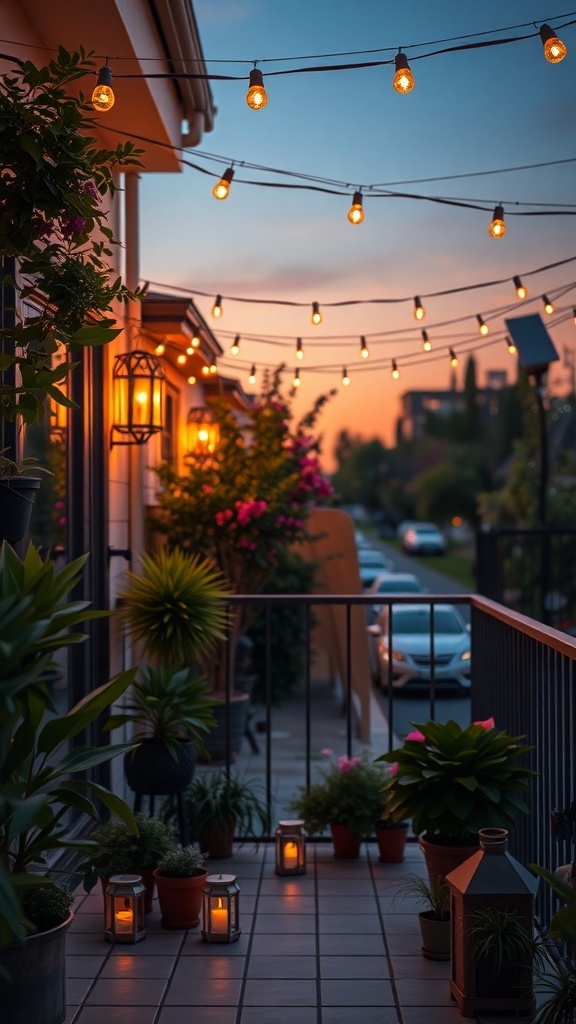
Lighting can transform your small balcony garden into a cozy retreat. Think about string lights draped across the railing or lanterns placed on the floor. These options create a warm glow that invites you to relax.
In the image, you can see how the soft light from the hanging bulbs and lanterns enhances the plants around. This setup not only looks beautiful but also makes the space usable during the evening.
Consider using solar-powered lights for an eco-friendly choice. They charge during the day and illuminate your balcony at night without adding to your electricity bill. This is a simple way to add charm and functionality.
Another idea is to use spotlights to highlight specific plants or features. This draws attention to your favorite blooms and adds depth to your garden. Layering different light sources can create a dynamic atmosphere.
Vertical Gardening Solutions
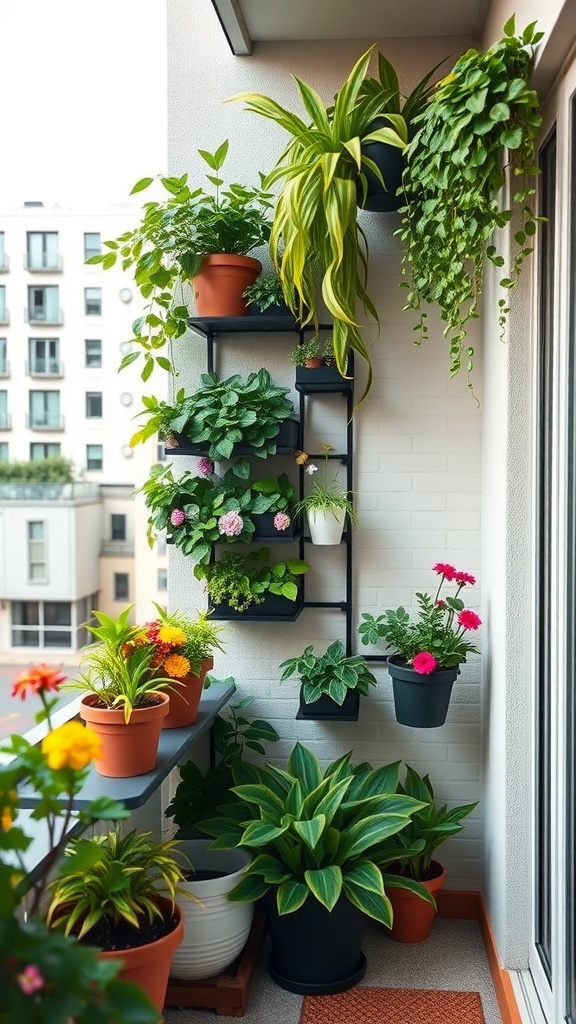
Vertical gardening is a fantastic way to maximize space on a small balcony. The image shows a well-organized vertical garden, showcasing a variety of plants in pots stacked on a sleek shelving unit. This setup not only saves floor space but also adds a vibrant touch to the balcony.
Using vertical structures allows you to grow more plants without needing a large area. You can mix flowers, herbs, and leafy greens to create a colorful and functional garden. The plants are arranged thoughtfully, making it easy to access and care for each one.
Consider using wall-mounted planters or hanging pots to further enhance your vertical garden. This approach can create a lush green wall that brings life to your outdoor space. Remember to choose plants that thrive in your climate and fit your balcony’s sunlight exposure.
Balcony Garden Maintenance Tips
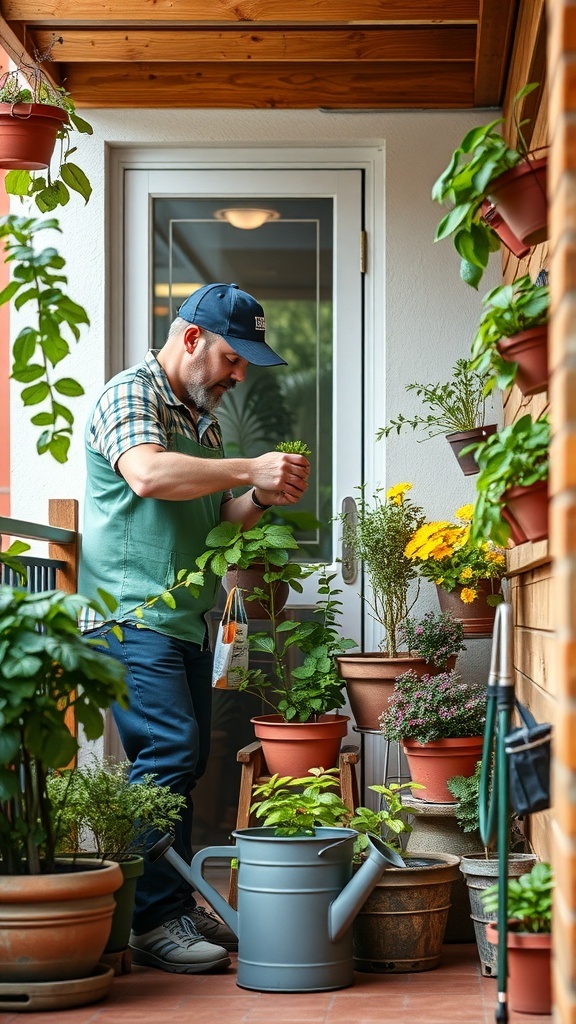
Maintaining a balcony garden can be a rewarding experience. The image shows a person tending to a variety of plants in pots, showcasing how vibrant and lively a small space can become. With a little care, your balcony can flourish.
Start by checking the sunlight your plants receive. Some plants thrive in full sun, while others prefer shade. Rotate your pots if needed to ensure even growth. Regularly inspect for pests and remove any dead leaves to keep your plants healthy.
Watering is key. Make sure to water your plants according to their needs. Overwatering can be just as harmful as underwatering. Use a watering can, like the one in the image, for precision.
Fertilizing your plants can help them grow stronger. Use organic fertilizers to provide essential nutrients. Timing is important; follow the instructions for the best results.
Lastly, don’t hesitate to prune your plants. This encourages new growth and keeps them looking tidy. Enjoy the process and watch your balcony garden thrive!
Water Feature Inspiration
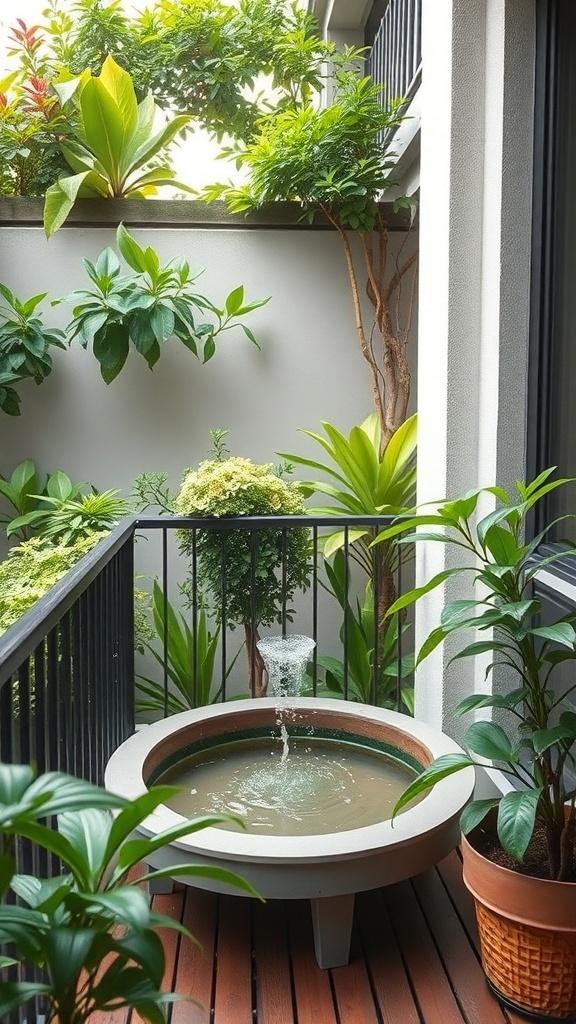
Water features can add a refreshing touch to any small balcony garden. The image shows a charming setup with a circular water basin that has a gentle fountain. This design not only looks appealing but also creates a soothing sound of flowing water.
Surrounding the water feature are lush green plants that enhance the natural vibe. The combination of the water and greenery can make the space feel more inviting. You might want to consider adding some colorful flowers nearby to bring in a pop of color.
For those with limited space, a compact water feature like this one is perfect. It doesn’t take up much room but still makes a big impact. Think about incorporating similar elements into your own balcony garden for a serene escape right at home.
Incorporating Edible Flowers
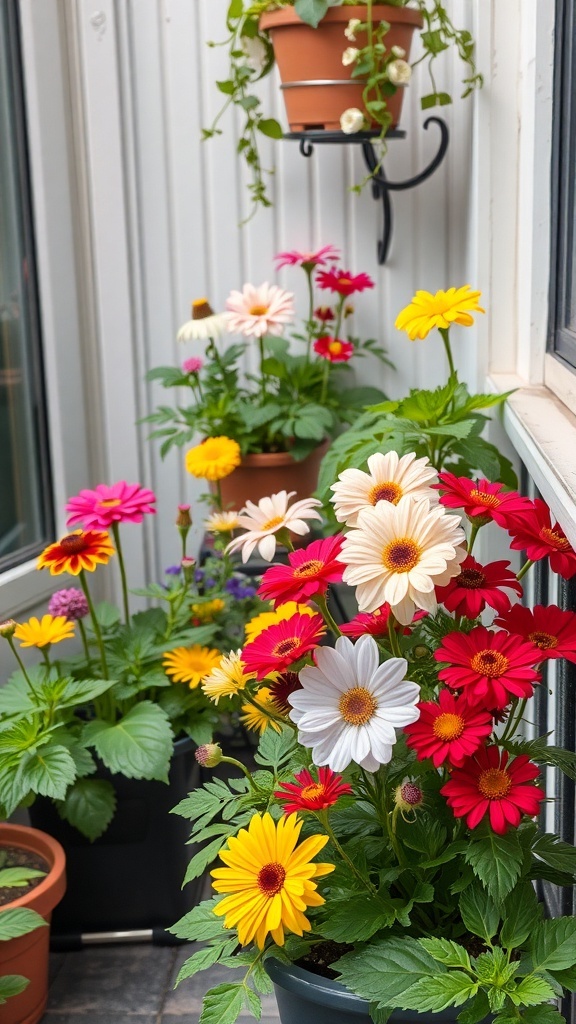
Bright and colorful flowers can do more than just beautify your balcony. They can also add a unique twist to your meals! Edible flowers like nasturtiums, pansies, and marigolds are perfect for small balcony gardens.
Imagine using vibrant nasturtium petals in a salad. Their peppery flavor adds a delightful kick. Pansies, with their sweet taste, can be used to decorate desserts or cocktails. Marigolds not only look stunning but also have a citrusy flavor that can enhance various dishes.
Planting these flowers is easy. They thrive in pots and can be grown alongside herbs and vegetables. Just make sure they get enough sunlight and water. You can create a mini garden that’s both beautiful and functional!
When harvesting, remember to pick flowers in the morning when they are fresh. Rinse them gently to remove any dirt or insects. Then, you’re ready to add a splash of color and flavor to your meals!
Wildlife-Friendly Balcony Gardens
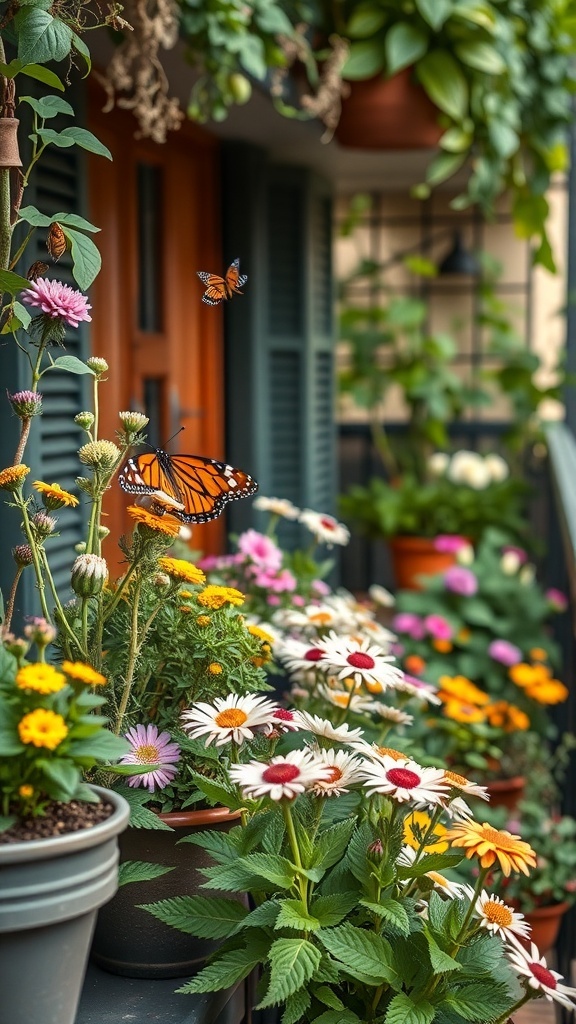
Creating a wildlife-friendly balcony garden can be a delightful experience. Imagine stepping out onto your balcony and seeing butterflies fluttering around vibrant flowers. This image captures that joy perfectly. The colorful blooms attract not just the eye, but also beneficial insects like bees and butterflies.
Choosing the right plants is key. Opt for native flowers that provide nectar and pollen. In this image, you can see a mix of daisies, marigolds, and other flowering plants. These choices help support local wildlife while adding beauty to your space.
Consider adding some small features like a birdbath or a bee hotel. These elements can encourage more wildlife to visit. Even a simple pot of herbs can attract pollinators. A wildlife-friendly balcony garden is not just about plants; it’s about creating a mini-ecosystem right at home.
Small Space Vegetable Gardening
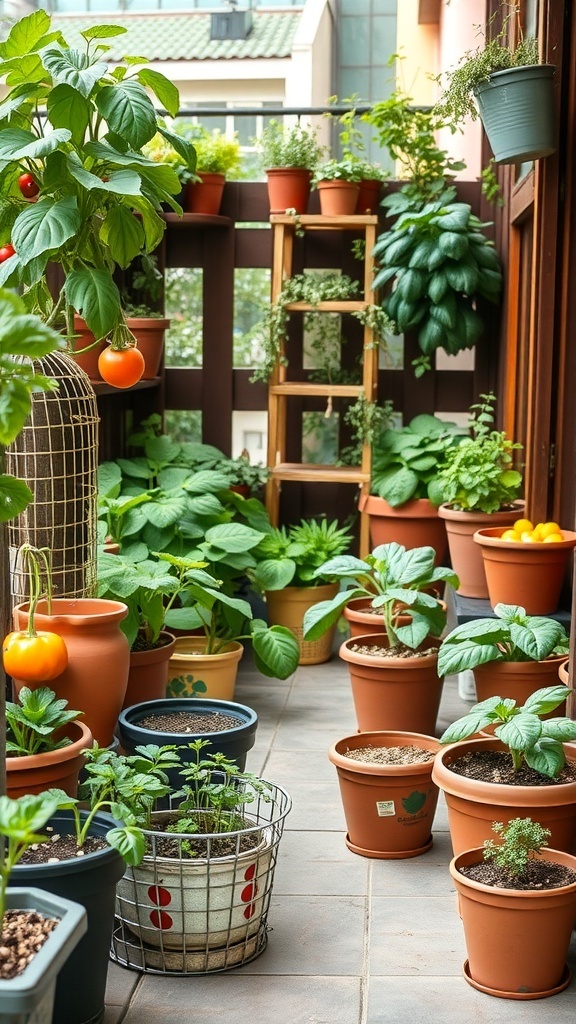
Creating a vegetable garden on a small balcony can be both fun and rewarding. The image shows a vibrant balcony filled with various plants in pots, showcasing how you can maximize limited space. You can see tomatoes, leafy greens, and herbs thriving in their containers.
Using pots allows for flexibility. You can choose different sizes and shapes to fit your balcony layout. The arrangement in the image highlights vertical gardening, with plants stacked on shelves. This method saves ground space while still allowing for plenty of greenery.
Consider using lightweight pots to make moving them easier. Herbs like basil and parsley are great starter plants. They don’t require much space and can be used in your cooking. Plus, they add a fresh touch to your meals.
Don’t forget about sunlight! Most vegetables need at least six hours of sunlight daily. Position your pots accordingly to ensure they get enough light. Watering is also key; make sure your pots have drainage holes to prevent overwatering.
Balcony Garden Decor Ideas

Creating a small balcony garden can be a delightful way to bring nature into your living space. This image showcases a charming balcony filled with a variety of plants and decorative elements. The mix of pots, from terracotta to ceramic, adds a splash of color and personality.
Consider using different sizes and shapes of pots to create visual interest. Tall cacti and lush ferns can add height and texture, while smaller flowering plants bring vibrant colors. Hanging planters can also save space and add dimension.
Incorporating wall art, like the framed picture and decorative wreaths seen here, can enhance the overall look. These personal touches make the space feel inviting and unique. A small table or bench can provide a cozy spot to relax and enjoy your garden.
Lighting is another key element. A lantern or string lights can create a warm atmosphere in the evenings. Think about how you can mix plants and decor to make your balcony a true reflection of your style.
Using Trellises for Climbing Plants

Trellises are a fantastic way to maximize space in a small balcony garden. They provide support for climbing plants, allowing them to grow upwards instead of outwards. This is especially useful when you have limited floor space.
In the image, you can see a lovely setup with vibrant plants cascading down from shelves. The trellis supports the climbing vines, creating a lush, green backdrop. This not only adds beauty but also creates a cozy atmosphere.
Consider using trellises for plants like peas, beans, or even flowering vines. They can add height and visual interest to your garden. Plus, they can help improve air circulation around the plants, which is great for their health.
When choosing a trellis, think about the style that fits your balcony. Wooden trellises can add a rustic charm, while metal ones might give a modern touch. Whatever you choose, make sure it’s sturdy enough to support your plants as they grow.
